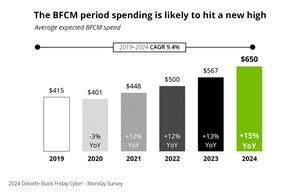Deloitte Benchmarking Study Uncovers Cost Reduction Opportunities in Retail
NEW YORK, Feb. 18 /PRNewswire/ -- Deloitte has released the results of a benchmarking study designed to quantify store operations and general and administrative (SGA) cost-improvement opportunities in retail. The study goes well beyond an analysis of back-office functions to cover retail-specific functions such as store operations, merchandising, supply chain and marketing across 120 different performance metrics.
"In a retail market characterized by diminished consumer spending, cost-management initiatives are more critical than ever," said John Rooney, principal and retail sector leader for Deloitte Consulting LLP. "Retailers are confronted with the challenge of reducing costs without negatively impacting the customer experience or hampering the organization's ability to grow as the economic climate improves."
"A strategy that addresses cost-improvement opportunities with a focus on the customer is crucial to sustaining business performance in a volatile environment. Such a strategy may enable retailers to shift recovered costs into areas that improve loyalty over the long term and position the organization for growth," Rooney added.
Conducted by Deloitte's Global Benchmarking Center, the study compared SGA functions against median and low-cost performers(1) in the group of participating retail organizations, and analyzed the gaps that point to significant potential for strategic cost reductions. Through the study, which included more than 60 high-profile retail organizations, Deloitte found that the low-cost performers have created distinctive characteristics over the median performers through strategies that include:
- A diverse advertising mix. The low-cost performers spend more on visual merchandising and online advertising than traditional print and TV/radio, which account for only 25 percent of their spend compared to 93 percent in the median group. The low-cost performers consistently place a higher percentage of their advertising spend on efforts that directly target the customer, such as loyalty programs, in-store displays and online activity.
- Strategic IT investments and in-house supply chain options. The study found that outsourcing is not necessarily generating lower costs, as the low-cost performers achieved a 36 percent lower IT cost through lower labor and technology spend compared to the median. In addition, the low-cost performers continued to manage many of their supply chain operations internally, and their costs in this area are 22 percent less than the median.
- Process innovation. The low-cost performers have 27 percent lower finance costs than the median. These retailers effectively leveraged finance process innovations that lead to cost savings, and use efficient technology and shared services to drastically reduce transaction costs and labor requirements.
- Smaller assortment and targeted merchandising spend. Fewer stock keeping units (SKUs) typically translate into less inventory complexity and less demand on labor, and the study found that the low-cost performers manage 35 percent fewer SKUs compared to the median. In addition, they spend 84 percent more on store operations technology, contributing to lower process costs.
- Greater staff investment in customer-facing areas. While retaining their low-cost performer status, participants in this group spend six percent more on store operations per billion in sales than the median. The low-cost performers focused their spending on customer-facing areas and achieved cost reductions in non-customer-facing areas.
"Equipped with benchmarking data and analysis, retailers may be able to identify potential opportunities to reallocate costs, such as moving spending from traditional back-office functions to new areas for investment such as marketing, IT and supply chain," said Rooney. "When mapping out a specific plan for cost improvements, retailers should consider focusing on actions that balance immediate, strategic and long term initiatives, which may enable organizations to stay on a forward track even during more challenging business cycles."
The report will be presented via webcast on Thursday, Feb. 18 at 11:00 a.m. ET. To download the report or register for the webcast, please visit: www.deloitte.com/us/SGA4Retail.
For more information about Deloitte's retail sector, please visit: www.deloitte.com/us/retail.
(1) Low-cost performer and median designations represent the 25th percentile and 50th percentile of the participating retail organizations, based on key performance metrics, within each of the eight functions that include: store operations, merchandising, supply chain management, marketing, information technology, finance, human resources and support services.
Methodology
The report is the result of a Deloitte Global Benchmarking Center study of store operations, general and administrative process performance. Deloitte gathered fiscal-year 2008 data across 40 process categories in eight functions including store operations, merchandising, supply chain management, marketing, information technology, finance, human resources and support services from 60 global retailers in categories including apparel, specialty, private-label and non-private label.
About Deloitte
As used in this document, "Deloitte" means Deloitte LLP and Deloitte Consulting LLP and Deloitte Services LP, which are separate subsidiaries of Deloitte LLP. Please see www.deloitte.com/us/about for a detailed description of the legal structure of Deloitte LLP and its subsidiaries.
SOURCE Deloitte
WANT YOUR COMPANY'S NEWS FEATURED ON PRNEWSWIRE.COM?
Newsrooms &
Influencers
Digital Media
Outlets
Journalists
Opted In






Share this article